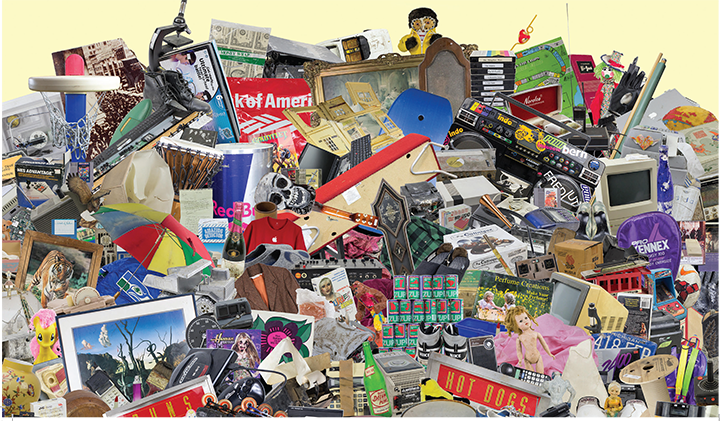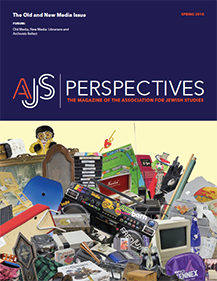
This transition from prophecy to Talmud is an important one. In the Hebrew Bible prophecy is understood as the word or “Spirit” of God ('דבר ה or רוח אלֹהים) coming upon the prophet in such a way that the prophet has no choice but to voice the word of God. It is no small thing for the prophet to hear such words. These are words of a creator God, words that were used to form the very universe itself, world-shaping words, cosmic words. The Torah was written down by God before creation, thus when God spoke to create the world he was actually reading aloud (Bereshit Rabbah 1:1). God taught the Jews to read his divine language, giving both the Oral and Written Torah at Sinai, according to the rabbis.
Historically speaking, the emergence of the written word in the Anthropocene meant a whole new medium, a whole new materiality for information. Words took on a physicality that they did not have before written texts. They no longer come to us through our ears but through our eyes. The talmudic method that developed brought the cosmic words back to ears, but not in the same way as prophecy, because to hear the words one must take part in communal back-and-forth, discussion, and argumentation.
For the rabbinic tradition, the Torah reshapes as time moves forward. Like a river it flows into new forms of media. Learned Jews thus need to be particularly adept at following that living fountain as it pours over new terrain. You could say that this is why the Jewish tradition is sometimes rather fixated on language and its new media. I would argue that different media present different terrains, have different ecologies, present different spaces in which information flows and communication takes place.
Really Old Media
There is a natural history to the flow of communication systems; indeed, you probably could not have biological life without at the same time having some sort of communication system. Even the most primitive organisms must be able to take in information from their environment and react to it in some way. In this way, processing information, cognition, and life are ways of doing the same thing. Indeed, we can say life evolved into written texts. Though, like Torah, there is an ambiguity because DNA is itself, as Robert Pollack notes in Signs of Life: The Language and Meanings of DNA, “a work of literature, a great historical text,” that is, the biological code that underwrites living things already is some sort of written text.
Communication systems change over time; different species may have vastly different forms, and some systems can be more adaptive in certain environments. Human animals, for example, have language, which shares many features with other animals, but seems to be particularly good at conveying complex information in the form of clear, repeatable propositions. The idea that some communication systems may be more adaptive is one possible explanation for the disappearance of Homo neanderthalensis and the expansion of Homo sapiens sapiens (anatomically modern humans) somewhere around 35–40,000 BP, or rather, one “technological adaptive system” which must have included robust linguistic ability, probably overwhelmed the one that did not.
In The Symbolic Species, Terrance Deacon argues that ancient human beings didn’t evolve to get language, rather language evolved to get us. You can think of language as something like a virus that adapted to us, rather than the other way around. If religions are like languages, perhaps we can say something similar about them. They adapt to us in time and space. Judaism, or what Jacob Neusner called “Judaic Systems,” appear adept at adapting to new media ecologies—because that’s where they find the word of YHWH, the language of life and creation.
It wasn’t until the age of agriculture at the end of the last ice age that the first writing systems (that we know of) began to emerge in human societies. It is just after this time that we find societies with specific classes of individuals who specialize in transacting with the written word: educators, rabbis, professors, and so on. Judaism is a particular form of such dedication.
We are now in the midst of the next great communicative transformation in the form of computer-mediated technologies.
Really New Media
The word of God may have flowed into books, radio, television, and film in the modern age, but in recent years it has really flowed into computer-mediated technologies. If you read Torah on a screen, the materiality is no longer ink and parchment or leather: at the most basic level it is zeros and ones in computer memory, which today is most often encoded as charged or uncharged electrons on an SSD. In his beautiful book, The Talmud and the Internet, Jonathan Rosen makes the case that the Talmud is a prefiguration of the Internet. Anyone who has used both technologies is likely to agree, especially in the way it is possible to go down infinite rabbit holes, meandering wormholes. The Talmud is hypertextually linked to the entire Jewish tradition, a mix of Oral and Written Torah.
The materiality of the Talmud provides the space in which we interact with that technology. In other words, unless it is a digitized version you are reading, you must actually pick up a book, flip some pages, search the letters with your eyes, to trace your path through the tradition. It is not only semantic information that is exchanged. We also must not forget about other economies: a full set of the Babylonian Talmud will set you back a few thousand dollars.
After the digital revolution, our media ecology has differentiated like no other time. We’ve learned a lot more about the wormholes. We’ve learned they can rigidify and sediment—so we get something like red and blue feeds on Facebook—we get our own personal streams curated by corporations and their AIs. I would argue that each platform can be differentiated with regard to its space and terrain. For example, compare the three most popular platforms of Twitter, Facebook, and Google. They have each carved a rather monolithic niche in Internet space. Importantly, they are all about the Word, about communication, but in quite different ways. Imagine how the Spirit of YHWH, which once came directly to the prophet, can inhabit these media spaces.
Monetization also works differently with the new media. It’s all free on the front end. Google, for example, lets you Google for free. You can search for anything you want with a few search terms. A secret algorithm controls what you see, where you go next. Google owns that information. Google knows a lot about how we search for things, what rabbinic Judaism calls derash. Google gets its power by controlling the way most people start on the Internet. It can afford to be open in this respect. By contrast Facebook has walls; Google search doesn’t access Facebook. There is an inside and an outside to your Facebook profile. Facebook controls your feed, guiding you mostly within its own platform, directing your attention. Because of the personal nature of the platform, Facebook is able to learn much more about you than just your search habits. Facebook owns this information. Twitter seems to still be trying to figure out the best way to monetize your behavior on its platform. Though they are experimenting with longer tweets, Twitter is driven much more by short messages. It is much more clearly professing the Word. The “leader of the free world” speaks to us relatively directly through Twitter.
As Yuri Slezkine writes in his book The Jewish Century, modernization is about “everyone becoming urban, mobile, literate, articulate, intellectually intricate, physically fastidious, and occupationally flexible. Thus modernization is about everyone becoming Jewish. . . . but no one is better at being Jewish than the Jews.” Judaic systems are flowing into these media. What will they look like in a thousand more years?

